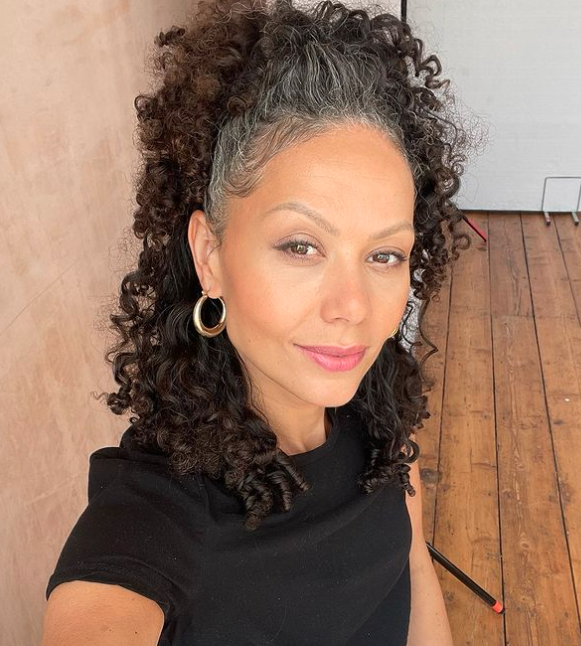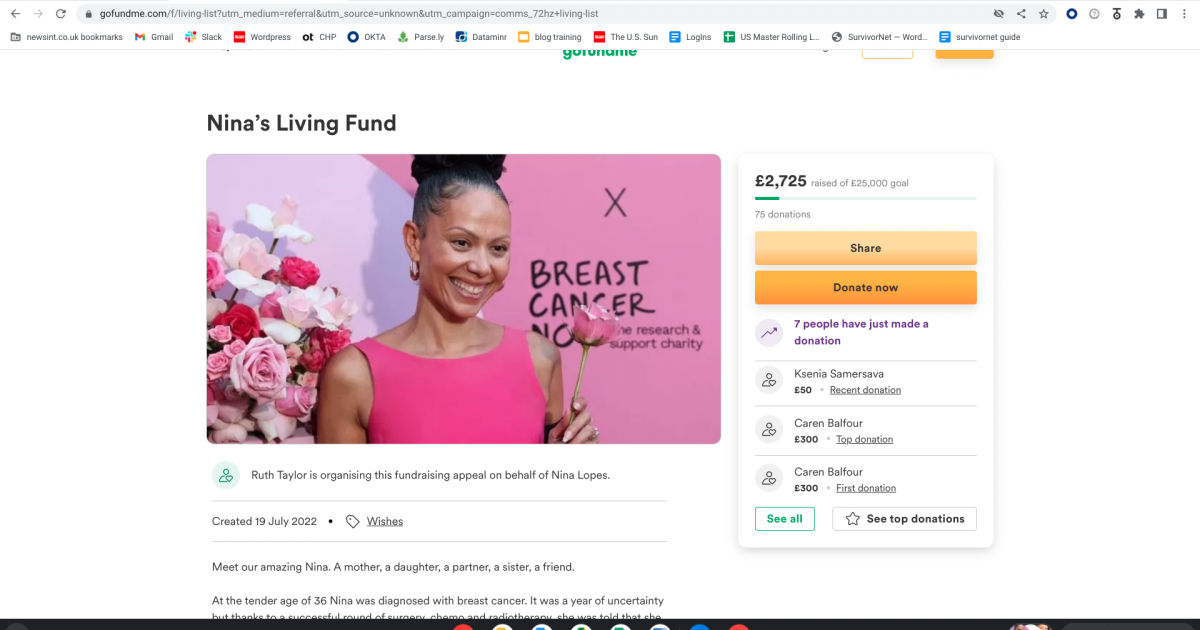Check Breasts & Know Your Body
- Nina Lopes, from Croydon, England, noticed a lump on her breast and contacted doctors who told her the bump was “normal.” However, she later learned it was cancer.
- If a woman has fibrocystic breasts, those symptoms can include breast pain, tenderness, lumps, and nipple discharge, according to the American Cancer Society. Experts say that women with fibrocystic breasts are still encouraged to do their own self-checksand get to know their own lumps and bumps to help familiarize what they feel like and to look out for any changes in between doctor visits and screenings for breast cancer.
- Women of African ancestry are likely to carry a gene that raises their risk for aggressive, triple-negative breast cancer.
“I didn’t feel like everything was right in my body. I was feeling extremely tired and watching something on my laptop while lying down,” Nina Lopes, from Croydon, England, told MyLondon. “A bit of popcorn fell on my chest. When I went to pick it up that’s when I felt a lump.”
Read MoreView this post on Instagram
After two years of being cancer-free, Lopes’ pain reappeared and doctors believed it was “a side effect of the treatment” she had undergone. She told MyLondon, “They kept trying to send me for physio, but eventually I put my foot down. The time came for me to have the last MRI on the NHS. I had my last MRI in July last year and that’s when they picked up that my cancer was back.”
Despite her cancer’s return, Lopes maintains her love for life and strives to make the most memories with her 11-year-old daughter Ilani. “It’s so important to me to make the most memories with my daughter,” she continued. “I know that at 11 you’re limited with what you can remember later in life. I would love to be here until she’s 16 so we can make memories.”
Lopes, who has taken to Instagram and TikTok to share her journey, urges other women to check their breasts and understand their bodies. She reminds her followers of the importance of “feeling empowered to know that if something is wrong, they can say something and ask for a second opinion.”
In addition to spreading awareness of self-breast checks, Lopes stresses the importance of hope. “With stage 4 it doesn’t get spoken about enough. Most of the stories are about someone beating cancer but so many of us are living with stage 4. Every three months I have to have a scan and spend seven days of holding my breath and waiting for the results,” she explained. “This is what many women and men like me are having to go through. We’re made to feel like it’s the end, a chronic illness. It feels like a constant battle having to advocate for yourself in order to have the best treatment possible. I want women like myself to be represented. I am mixed-race.”
A GoFundMe has been created for Lopes in an effort to raise money for additional costly treatments. It reads: “As treatment options begin to narrow on the NHS, Nina is currently seeking clinical trials, alternative medicine, holistic therapies and supplements that will ease and prolong quality of life. This however, all comes at a considerable cost.”

What are Fibrocystic Breasts?
Anyone with Fibrocystic breast disease should be aware it is not considered a typical disease, so some experts have been dropping the word “disease” from the name and simply referring to it as "fibrocystic breasts" or "fibrocystic breast changes." These types of breasts are lumpy and painful, which worsen during your menstrual cycle.
Symptoms of fibrocystic breasts can include breast pain, tenderness, lumps and nipple discharge.
Women with fibrocystic breasts are still urged to do their own self-checksand get to know their own lumps and bumps to help familiarize what they feel like and to look out for any changes in between doctor visits and screenings for breast cancer.
Getting Screened for Breast Cancer
For breast cancer prevention, leading experts say that there are risk factors you can focus on improving, like drinking less alcohol and exercising more, but there are things you cannot change, like your family history and genetics.
According to the American Cancer Society, women between the ages of 40-44 “should have the choice” on whether or not to start their breast cancer screenings and mammograms, which are scans of your breasts. From 45-54, women should get annual mammograms, and women 55 and older could screen every two years or keep the annual screening depending what is best for them. Your family history may affect what age you should start getting mammograms, so it's best to discuss your health and history with your own doctor to determine what is best for your unique situation.
Breast Cancer Introduction to Prevention & Screening
Getting To Know Triple-Negative Breast Cancer
Breast cancer is the most common cancer among women in the United States, according to the U.S. Centers for Disease Control and Prevention. (In the U.K., where Lopes is from, there are about 55,000 cases of the disease diagnosed each year.)
Triple-negative breast cancer is one of the most aggressive forms of the disease and accounts for about 20% of all breast cancers in the U.S.
Triple-negative breast cancer doesn't have any of the main drivers of breast cancer the estrogen receptor, the progesterone receptor or the HER2 receptor and consequently doesn't respond to treatments that target them. The most popular treatment for this type of breast cancer is chemotherapy, immunotherapy or participation in clinical trials.
If a patient has metastatic (stage 4) triple-negative breast cancer, the usual first line of therapy is chemotherapy. There are different chemotherapy options depending on the burden of disease, which refers to how sick someone is with their disease. Triple-negative breast cancer is usually responsive to chemotherapy.
Related: Getting to Know Your Breasts with Self-Exams
"If the disease burden is not too great, meaning that a woman doesn't have a lot of symptoms, we can often start with oral chemotherapy," Dr. Elizabeth Comen, a breast oncologist at Memorial Sloan Kettering Cancer Center, told SurvivorNet during a previous interview.
In certain instances, a patient will become resistant to their first line of therapy and will have to switch to another chemotherapy. There are many different chemotherapies that are used for triple-negative breast cancer. There are also different clinical trials that may be available to patients.
Contributing: SurvivorNet Staff
Learn more about SurvivorNet's rigorous medical review process.


